BA Business Management: Management Accounting Budgeting Role Analysis
VerifiedAdded on 2023/01/09
|7
|2055
|92
Essay
AI Summary
This essay provides a comprehensive analysis of the role of budgeting within management accounting, emphasizing its importance in contemporary business decision-making. It explores the application of budgeting concepts, including static and flexible budgeting styles, using Tesco Plc as a contextual example. The essay critically evaluates the merits and demerits of participative budgeting, considering its implications for organizational performance and decision-making processes. The discussion encompasses the relationship between short-term plans and budgeting, highlighting how budgeting facilitates the translation of medium-term strategies into actionable short-term objectives. The analysis also examines the benefits and drawbacks of different budgeting approaches, providing insights into their practical applications and potential challenges. The essay concludes by summarizing the key findings and emphasizing the significance of effective budgeting in achieving organizational goals.

Management AccountingManagement Accounting
1
1
Paraphrase This Document
Need a fresh take? Get an instant paraphrase of this document with our AI Paraphraser
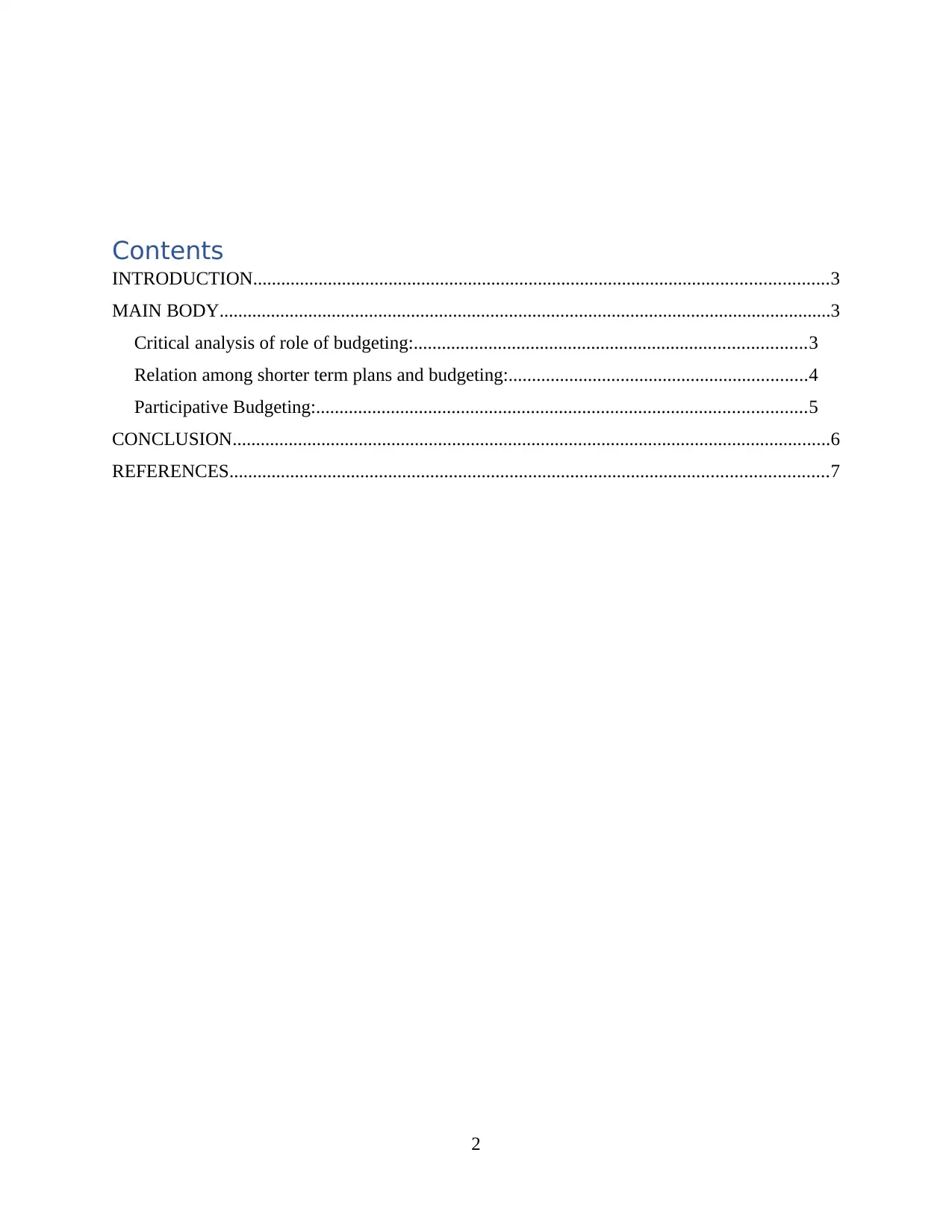
Contents
INTRODUCTION...........................................................................................................................3
MAIN BODY...................................................................................................................................3
Critical analysis of role of budgeting:....................................................................................3
Relation among shorter term plans and budgeting:................................................................4
Participative Budgeting:.........................................................................................................5
CONCLUSION................................................................................................................................6
REFERENCES................................................................................................................................7
2
INTRODUCTION...........................................................................................................................3
MAIN BODY...................................................................................................................................3
Critical analysis of role of budgeting:....................................................................................3
Relation among shorter term plans and budgeting:................................................................4
Participative Budgeting:.........................................................................................................5
CONCLUSION................................................................................................................................6
REFERENCES................................................................................................................................7
2
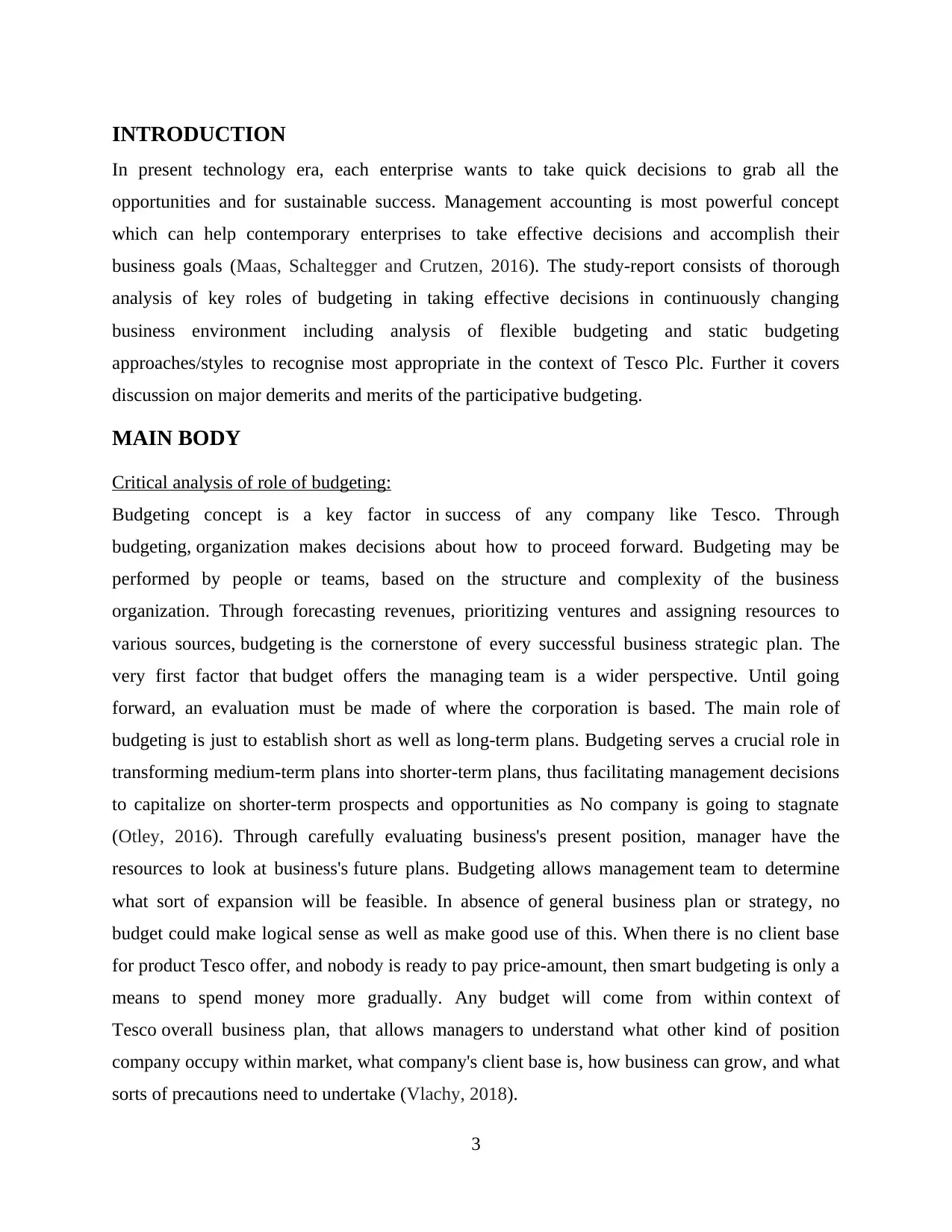
INTRODUCTION
In present technology era, each enterprise wants to take quick decisions to grab all the
opportunities and for sustainable success. Management accounting is most powerful concept
which can help contemporary enterprises to take effective decisions and accomplish their
business goals (Maas, Schaltegger and Crutzen, 2016). The study-report consists of thorough
analysis of key roles of budgeting in taking effective decisions in continuously changing
business environment including analysis of flexible budgeting and static budgeting
approaches/styles to recognise most appropriate in the context of Tesco Plc. Further it covers
discussion on major demerits and merits of the participative budgeting.
MAIN BODY
Critical analysis of role of budgeting:
Budgeting concept is a key factor in success of any company like Tesco. Through
budgeting, organization makes decisions about how to proceed forward. Budgeting may be
performed by people or teams, based on the structure and complexity of the business
organization. Through forecasting revenues, prioritizing ventures and assigning resources to
various sources, budgeting is the cornerstone of every successful business strategic plan. The
very first factor that budget offers the managing team is a wider perspective. Until going
forward, an evaluation must be made of where the corporation is based. The main role of
budgeting is just to establish short as well as long-term plans. Budgeting serves a crucial role in
transforming medium-term plans into shorter-term plans, thus facilitating management decisions
to capitalize on shorter-term prospects and opportunities as No company is going to stagnate
(Otley, 2016). Through carefully evaluating business's present position, manager have the
resources to look at business's future plans. Budgeting allows management team to determine
what sort of expansion will be feasible. In absence of general business plan or strategy, no
budget could make logical sense as well as make good use of this. When there is no client base
for product Tesco offer, and nobody is ready to pay price-amount, then smart budgeting is only a
means to spend money more gradually. Any budget will come from within context of
Tesco overall business plan, that allows managers to understand what other kind of position
company occupy within market, what company's client base is, how business can grow, and what
sorts of precautions need to undertake (Vlachy, 2018).
3
In present technology era, each enterprise wants to take quick decisions to grab all the
opportunities and for sustainable success. Management accounting is most powerful concept
which can help contemporary enterprises to take effective decisions and accomplish their
business goals (Maas, Schaltegger and Crutzen, 2016). The study-report consists of thorough
analysis of key roles of budgeting in taking effective decisions in continuously changing
business environment including analysis of flexible budgeting and static budgeting
approaches/styles to recognise most appropriate in the context of Tesco Plc. Further it covers
discussion on major demerits and merits of the participative budgeting.
MAIN BODY
Critical analysis of role of budgeting:
Budgeting concept is a key factor in success of any company like Tesco. Through
budgeting, organization makes decisions about how to proceed forward. Budgeting may be
performed by people or teams, based on the structure and complexity of the business
organization. Through forecasting revenues, prioritizing ventures and assigning resources to
various sources, budgeting is the cornerstone of every successful business strategic plan. The
very first factor that budget offers the managing team is a wider perspective. Until going
forward, an evaluation must be made of where the corporation is based. The main role of
budgeting is just to establish short as well as long-term plans. Budgeting serves a crucial role in
transforming medium-term plans into shorter-term plans, thus facilitating management decisions
to capitalize on shorter-term prospects and opportunities as No company is going to stagnate
(Otley, 2016). Through carefully evaluating business's present position, manager have the
resources to look at business's future plans. Budgeting allows management team to determine
what sort of expansion will be feasible. In absence of general business plan or strategy, no
budget could make logical sense as well as make good use of this. When there is no client base
for product Tesco offer, and nobody is ready to pay price-amount, then smart budgeting is only a
means to spend money more gradually. Any budget will come from within context of
Tesco overall business plan, that allows managers to understand what other kind of position
company occupy within market, what company's client base is, how business can grow, and what
sorts of precautions need to undertake (Vlachy, 2018).
3
⊘ This is a preview!⊘
Do you want full access?
Subscribe today to unlock all pages.

Trusted by 1+ million students worldwide
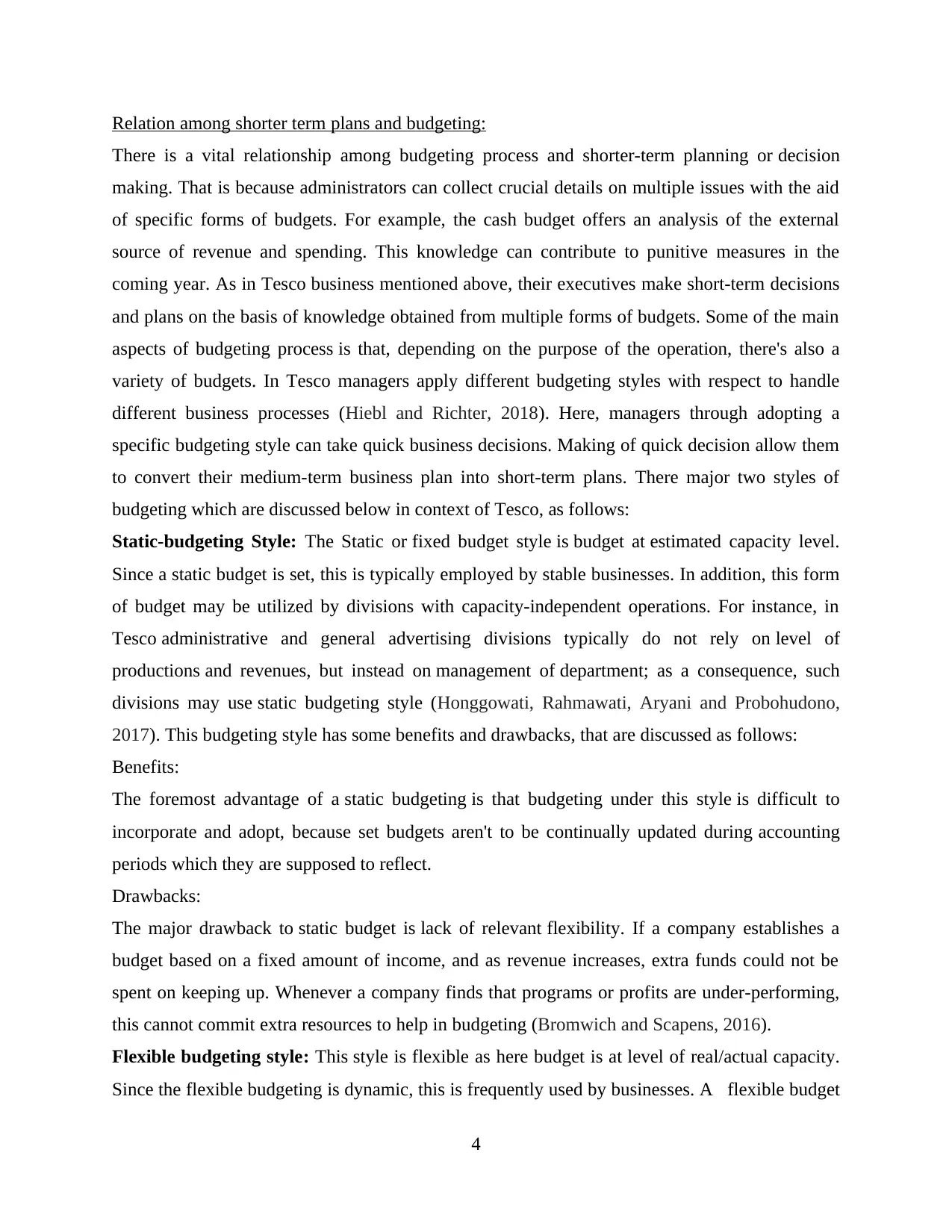
Relation among shorter term plans and budgeting:
There is a vital relationship among budgeting process and shorter-term planning or decision
making. That is because administrators can collect crucial details on multiple issues with the aid
of specific forms of budgets. For example, the cash budget offers an analysis of the external
source of revenue and spending. This knowledge can contribute to punitive measures in the
coming year. As in Tesco business mentioned above, their executives make short-term decisions
and plans on the basis of knowledge obtained from multiple forms of budgets. Some of the main
aspects of budgeting process is that, depending on the purpose of the operation, there's also a
variety of budgets. In Tesco managers apply different budgeting styles with respect to handle
different business processes (Hiebl and Richter, 2018). Here, managers through adopting a
specific budgeting style can take quick business decisions. Making of quick decision allow them
to convert their medium-term business plan into short-term plans. There major two styles of
budgeting which are discussed below in context of Tesco, as follows:
Static-budgeting Style: The Static or fixed budget style is budget at estimated capacity level.
Since a static budget is set, this is typically employed by stable businesses. In addition, this form
of budget may be utilized by divisions with capacity-independent operations. For instance, in
Tesco administrative and general advertising divisions typically do not rely on level of
productions and revenues, but instead on management of department; as a consequence, such
divisions may use static budgeting style (Honggowati, Rahmawati, Aryani and Probohudono,
2017). This budgeting style has some benefits and drawbacks, that are discussed as follows:
Benefits:
The foremost advantage of a static budgeting is that budgeting under this style is difficult to
incorporate and adopt, because set budgets aren't to be continually updated during accounting
periods which they are supposed to reflect.
Drawbacks:
The major drawback to static budget is lack of relevant flexibility. If a company establishes a
budget based on a fixed amount of income, and as revenue increases, extra funds could not be
spent on keeping up. Whenever a company finds that programs or profits are under-performing,
this cannot commit extra resources to help in budgeting (Bromwich and Scapens, 2016).
Flexible budgeting style: This style is flexible as here budget is at level of real/actual capacity.
Since the flexible budgeting is dynamic, this is frequently used by businesses. A flexible budget
4
There is a vital relationship among budgeting process and shorter-term planning or decision
making. That is because administrators can collect crucial details on multiple issues with the aid
of specific forms of budgets. For example, the cash budget offers an analysis of the external
source of revenue and spending. This knowledge can contribute to punitive measures in the
coming year. As in Tesco business mentioned above, their executives make short-term decisions
and plans on the basis of knowledge obtained from multiple forms of budgets. Some of the main
aspects of budgeting process is that, depending on the purpose of the operation, there's also a
variety of budgets. In Tesco managers apply different budgeting styles with respect to handle
different business processes (Hiebl and Richter, 2018). Here, managers through adopting a
specific budgeting style can take quick business decisions. Making of quick decision allow them
to convert their medium-term business plan into short-term plans. There major two styles of
budgeting which are discussed below in context of Tesco, as follows:
Static-budgeting Style: The Static or fixed budget style is budget at estimated capacity level.
Since a static budget is set, this is typically employed by stable businesses. In addition, this form
of budget may be utilized by divisions with capacity-independent operations. For instance, in
Tesco administrative and general advertising divisions typically do not rely on level of
productions and revenues, but instead on management of department; as a consequence, such
divisions may use static budgeting style (Honggowati, Rahmawati, Aryani and Probohudono,
2017). This budgeting style has some benefits and drawbacks, that are discussed as follows:
Benefits:
The foremost advantage of a static budgeting is that budgeting under this style is difficult to
incorporate and adopt, because set budgets aren't to be continually updated during accounting
periods which they are supposed to reflect.
Drawbacks:
The major drawback to static budget is lack of relevant flexibility. If a company establishes a
budget based on a fixed amount of income, and as revenue increases, extra funds could not be
spent on keeping up. Whenever a company finds that programs or profits are under-performing,
this cannot commit extra resources to help in budgeting (Bromwich and Scapens, 2016).
Flexible budgeting style: This style is flexible as here budget is at level of real/actual capacity.
Since the flexible budgeting is dynamic, this is frequently used by businesses. A flexible budget
4
Paraphrase This Document
Need a fresh take? Get an instant paraphrase of this document with our AI Paraphraser
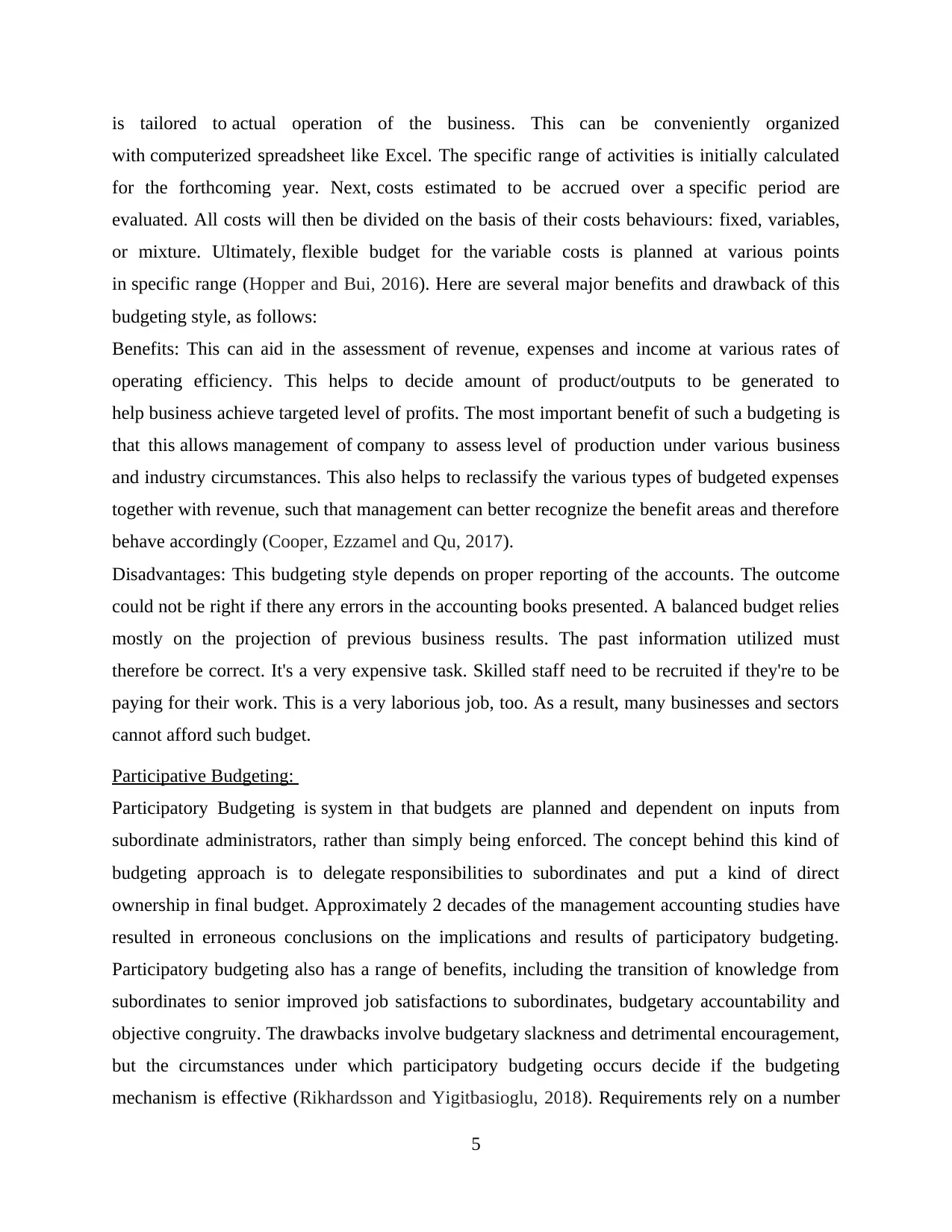
is tailored to actual operation of the business. This can be conveniently organized
with computerized spreadsheet like Excel. The specific range of activities is initially calculated
for the forthcoming year. Next, costs estimated to be accrued over a specific period are
evaluated. All costs will then be divided on the basis of their costs behaviours: fixed, variables,
or mixture. Ultimately, flexible budget for the variable costs is planned at various points
in specific range (Hopper and Bui, 2016). Here are several major benefits and drawback of this
budgeting style, as follows:
Benefits: This can aid in the assessment of revenue, expenses and income at various rates of
operating efficiency. This helps to decide amount of product/outputs to be generated to
help business achieve targeted level of profits. The most important benefit of such a budgeting is
that this allows management of company to assess level of production under various business
and industry circumstances. This also helps to reclassify the various types of budgeted expenses
together with revenue, such that management can better recognize the benefit areas and therefore
behave accordingly (Cooper, Ezzamel and Qu, 2017).
Disadvantages: This budgeting style depends on proper reporting of the accounts. The outcome
could not be right if there any errors in the accounting books presented. A balanced budget relies
mostly on the projection of previous business results. The past information utilized must
therefore be correct. It's a very expensive task. Skilled staff need to be recruited if they're to be
paying for their work. This is a very laborious job, too. As a result, many businesses and sectors
cannot afford such budget.
Participative Budgeting:
Participatory Budgeting is system in that budgets are planned and dependent on inputs from
subordinate administrators, rather than simply being enforced. The concept behind this kind of
budgeting approach is to delegate responsibilities to subordinates and put a kind of direct
ownership in final budget. Approximately 2 decades of the management accounting studies have
resulted in erroneous conclusions on the implications and results of participatory budgeting.
Participatory budgeting also has a range of benefits, including the transition of knowledge from
subordinates to senior improved job satisfactions to subordinates, budgetary accountability and
objective congruity. The drawbacks involve budgetary slackness and detrimental encouragement,
but the circumstances under which participatory budgeting occurs decide if the budgeting
mechanism is effective (Rikhardsson and Yigitbasioglu, 2018). Requirements rely on a number
5
with computerized spreadsheet like Excel. The specific range of activities is initially calculated
for the forthcoming year. Next, costs estimated to be accrued over a specific period are
evaluated. All costs will then be divided on the basis of their costs behaviours: fixed, variables,
or mixture. Ultimately, flexible budget for the variable costs is planned at various points
in specific range (Hopper and Bui, 2016). Here are several major benefits and drawback of this
budgeting style, as follows:
Benefits: This can aid in the assessment of revenue, expenses and income at various rates of
operating efficiency. This helps to decide amount of product/outputs to be generated to
help business achieve targeted level of profits. The most important benefit of such a budgeting is
that this allows management of company to assess level of production under various business
and industry circumstances. This also helps to reclassify the various types of budgeted expenses
together with revenue, such that management can better recognize the benefit areas and therefore
behave accordingly (Cooper, Ezzamel and Qu, 2017).
Disadvantages: This budgeting style depends on proper reporting of the accounts. The outcome
could not be right if there any errors in the accounting books presented. A balanced budget relies
mostly on the projection of previous business results. The past information utilized must
therefore be correct. It's a very expensive task. Skilled staff need to be recruited if they're to be
paying for their work. This is a very laborious job, too. As a result, many businesses and sectors
cannot afford such budget.
Participative Budgeting:
Participatory Budgeting is system in that budgets are planned and dependent on inputs from
subordinate administrators, rather than simply being enforced. The concept behind this kind of
budgeting approach is to delegate responsibilities to subordinates and put a kind of direct
ownership in final budget. Approximately 2 decades of the management accounting studies have
resulted in erroneous conclusions on the implications and results of participatory budgeting.
Participatory budgeting also has a range of benefits, including the transition of knowledge from
subordinates to senior improved job satisfactions to subordinates, budgetary accountability and
objective congruity. The drawbacks involve budgetary slackness and detrimental encouragement,
but the circumstances under which participatory budgeting occurs decide if the budgeting
mechanism is effective (Rikhardsson and Yigitbasioglu, 2018). Requirements rely on a number
5
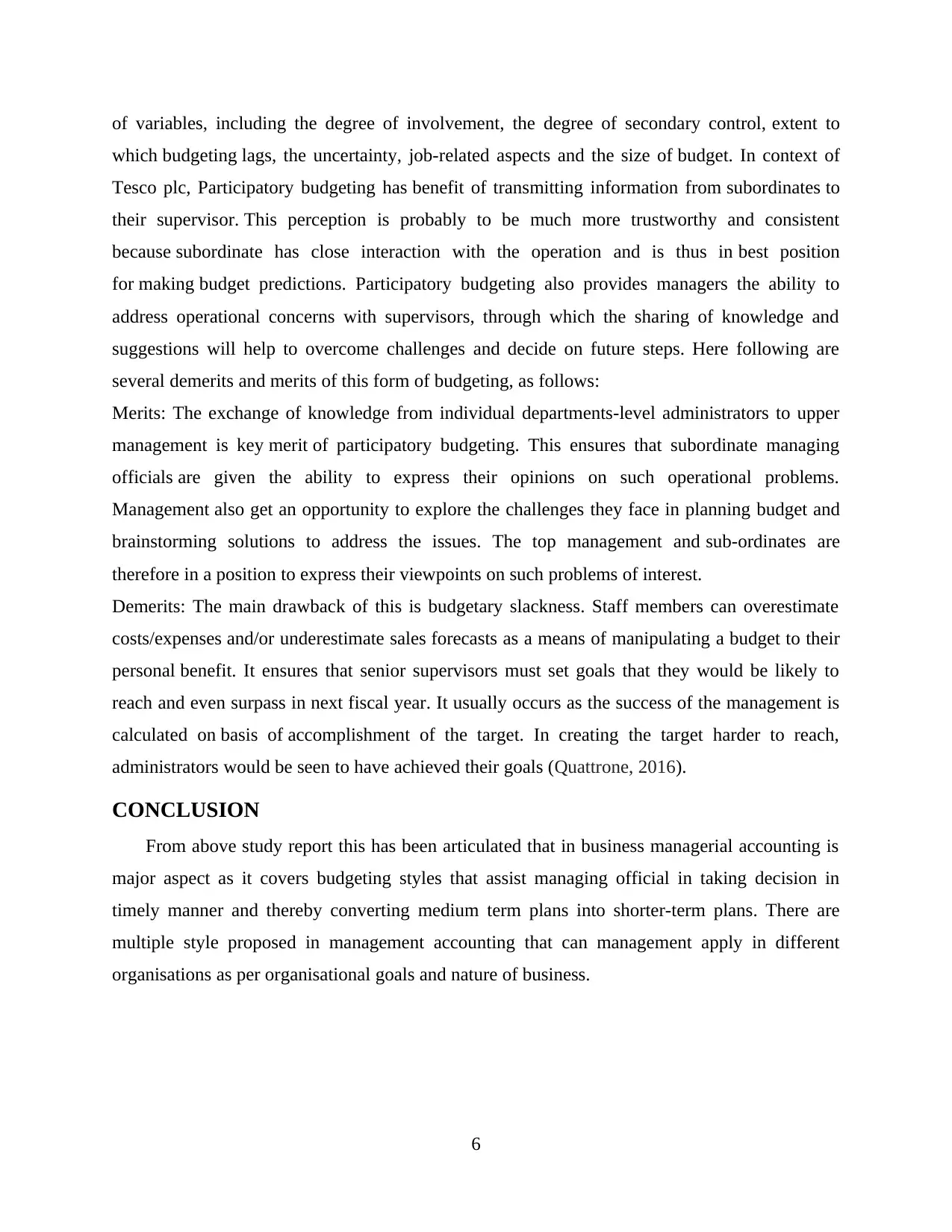
of variables, including the degree of involvement, the degree of secondary control, extent to
which budgeting lags, the uncertainty, job-related aspects and the size of budget. In context of
Tesco plc, Participatory budgeting has benefit of transmitting information from subordinates to
their supervisor. This perception is probably to be much more trustworthy and consistent
because subordinate has close interaction with the operation and is thus in best position
for making budget predictions. Participatory budgeting also provides managers the ability to
address operational concerns with supervisors, through which the sharing of knowledge and
suggestions will help to overcome challenges and decide on future steps. Here following are
several demerits and merits of this form of budgeting, as follows:
Merits: The exchange of knowledge from individual departments-level administrators to upper
management is key merit of participatory budgeting. This ensures that subordinate managing
officials are given the ability to express their opinions on such operational problems.
Management also get an opportunity to explore the challenges they face in planning budget and
brainstorming solutions to address the issues. The top management and sub-ordinates are
therefore in a position to express their viewpoints on such problems of interest.
Demerits: The main drawback of this is budgetary slackness. Staff members can overestimate
costs/expenses and/or underestimate sales forecasts as a means of manipulating a budget to their
personal benefit. It ensures that senior supervisors must set goals that they would be likely to
reach and even surpass in next fiscal year. It usually occurs as the success of the management is
calculated on basis of accomplishment of the target. In creating the target harder to reach,
administrators would be seen to have achieved their goals (Quattrone, 2016).
CONCLUSION
From above study report this has been articulated that in business managerial accounting is
major aspect as it covers budgeting styles that assist managing official in taking decision in
timely manner and thereby converting medium term plans into shorter-term plans. There are
multiple style proposed in management accounting that can management apply in different
organisations as per organisational goals and nature of business.
6
which budgeting lags, the uncertainty, job-related aspects and the size of budget. In context of
Tesco plc, Participatory budgeting has benefit of transmitting information from subordinates to
their supervisor. This perception is probably to be much more trustworthy and consistent
because subordinate has close interaction with the operation and is thus in best position
for making budget predictions. Participatory budgeting also provides managers the ability to
address operational concerns with supervisors, through which the sharing of knowledge and
suggestions will help to overcome challenges and decide on future steps. Here following are
several demerits and merits of this form of budgeting, as follows:
Merits: The exchange of knowledge from individual departments-level administrators to upper
management is key merit of participatory budgeting. This ensures that subordinate managing
officials are given the ability to express their opinions on such operational problems.
Management also get an opportunity to explore the challenges they face in planning budget and
brainstorming solutions to address the issues. The top management and sub-ordinates are
therefore in a position to express their viewpoints on such problems of interest.
Demerits: The main drawback of this is budgetary slackness. Staff members can overestimate
costs/expenses and/or underestimate sales forecasts as a means of manipulating a budget to their
personal benefit. It ensures that senior supervisors must set goals that they would be likely to
reach and even surpass in next fiscal year. It usually occurs as the success of the management is
calculated on basis of accomplishment of the target. In creating the target harder to reach,
administrators would be seen to have achieved their goals (Quattrone, 2016).
CONCLUSION
From above study report this has been articulated that in business managerial accounting is
major aspect as it covers budgeting styles that assist managing official in taking decision in
timely manner and thereby converting medium term plans into shorter-term plans. There are
multiple style proposed in management accounting that can management apply in different
organisations as per organisational goals and nature of business.
6
⊘ This is a preview!⊘
Do you want full access?
Subscribe today to unlock all pages.

Trusted by 1+ million students worldwide
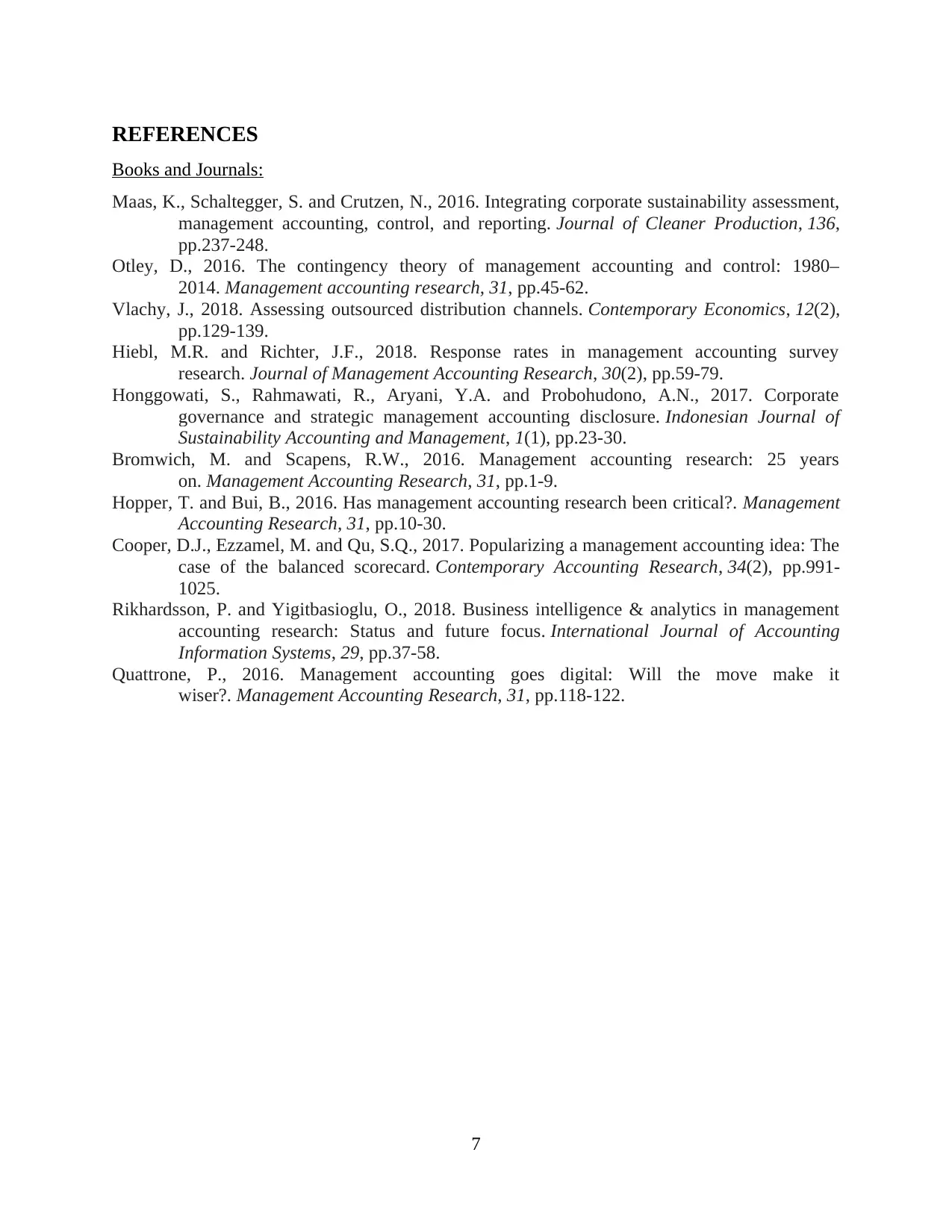
REFERENCES
Books and Journals:
Maas, K., Schaltegger, S. and Crutzen, N., 2016. Integrating corporate sustainability assessment,
management accounting, control, and reporting. Journal of Cleaner Production, 136,
pp.237-248.
Otley, D., 2016. The contingency theory of management accounting and control: 1980–
2014. Management accounting research, 31, pp.45-62.
Vlachy, J., 2018. Assessing outsourced distribution channels. Contemporary Economics, 12(2),
pp.129-139.
Hiebl, M.R. and Richter, J.F., 2018. Response rates in management accounting survey
research. Journal of Management Accounting Research, 30(2), pp.59-79.
Honggowati, S., Rahmawati, R., Aryani, Y.A. and Probohudono, A.N., 2017. Corporate
governance and strategic management accounting disclosure. Indonesian Journal of
Sustainability Accounting and Management, 1(1), pp.23-30.
Bromwich, M. and Scapens, R.W., 2016. Management accounting research: 25 years
on. Management Accounting Research, 31, pp.1-9.
Hopper, T. and Bui, B., 2016. Has management accounting research been critical?. Management
Accounting Research, 31, pp.10-30.
Cooper, D.J., Ezzamel, M. and Qu, S.Q., 2017. Popularizing a management accounting idea: The
case of the balanced scorecard. Contemporary Accounting Research, 34(2), pp.991-
1025.
Rikhardsson, P. and Yigitbasioglu, O., 2018. Business intelligence & analytics in management
accounting research: Status and future focus. International Journal of Accounting
Information Systems, 29, pp.37-58.
Quattrone, P., 2016. Management accounting goes digital: Will the move make it
wiser?. Management Accounting Research, 31, pp.118-122.
7
Books and Journals:
Maas, K., Schaltegger, S. and Crutzen, N., 2016. Integrating corporate sustainability assessment,
management accounting, control, and reporting. Journal of Cleaner Production, 136,
pp.237-248.
Otley, D., 2016. The contingency theory of management accounting and control: 1980–
2014. Management accounting research, 31, pp.45-62.
Vlachy, J., 2018. Assessing outsourced distribution channels. Contemporary Economics, 12(2),
pp.129-139.
Hiebl, M.R. and Richter, J.F., 2018. Response rates in management accounting survey
research. Journal of Management Accounting Research, 30(2), pp.59-79.
Honggowati, S., Rahmawati, R., Aryani, Y.A. and Probohudono, A.N., 2017. Corporate
governance and strategic management accounting disclosure. Indonesian Journal of
Sustainability Accounting and Management, 1(1), pp.23-30.
Bromwich, M. and Scapens, R.W., 2016. Management accounting research: 25 years
on. Management Accounting Research, 31, pp.1-9.
Hopper, T. and Bui, B., 2016. Has management accounting research been critical?. Management
Accounting Research, 31, pp.10-30.
Cooper, D.J., Ezzamel, M. and Qu, S.Q., 2017. Popularizing a management accounting idea: The
case of the balanced scorecard. Contemporary Accounting Research, 34(2), pp.991-
1025.
Rikhardsson, P. and Yigitbasioglu, O., 2018. Business intelligence & analytics in management
accounting research: Status and future focus. International Journal of Accounting
Information Systems, 29, pp.37-58.
Quattrone, P., 2016. Management accounting goes digital: Will the move make it
wiser?. Management Accounting Research, 31, pp.118-122.
7
1 out of 7
Related Documents
Your All-in-One AI-Powered Toolkit for Academic Success.
+13062052269
info@desklib.com
Available 24*7 on WhatsApp / Email
![[object Object]](/_next/static/media/star-bottom.7253800d.svg)
Unlock your academic potential
Copyright © 2020–2025 A2Z Services. All Rights Reserved. Developed and managed by ZUCOL.




